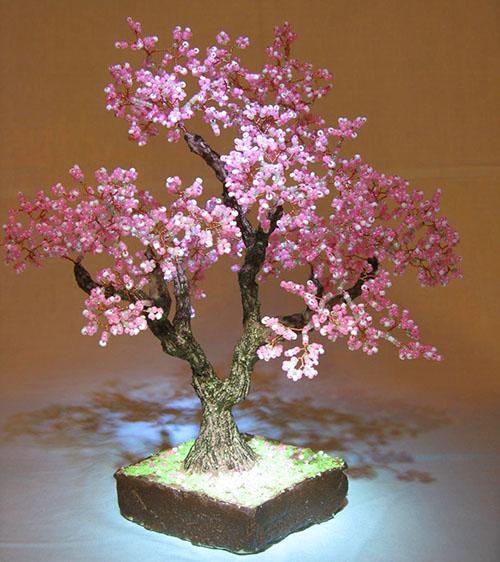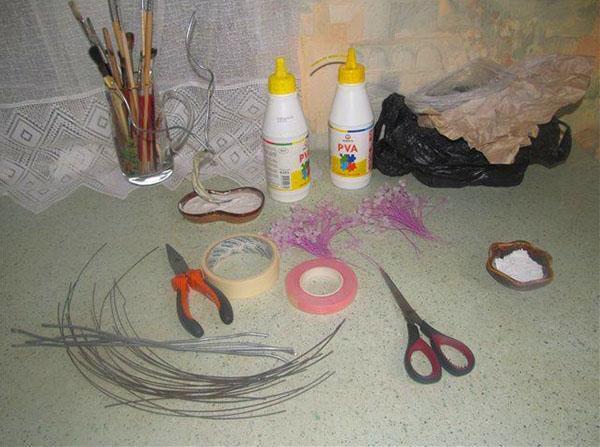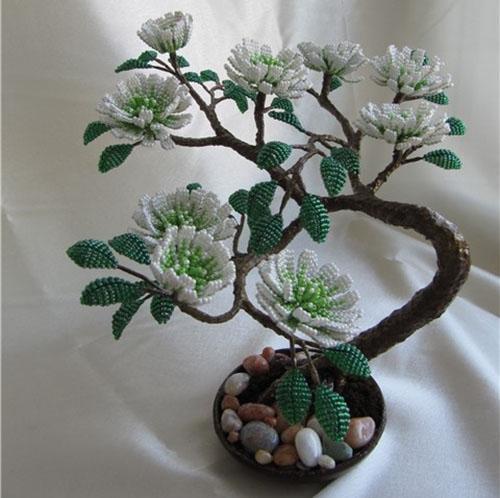DIY interior decoration - bead bonsai
 Miniature bonsai trees are the creations of the skilled hands of gardeners who devote decades to maintaining their ideal shape. Making a bonsai from beads requires the same painstaking work, but the effect of such an interior decoration is no less!
Miniature bonsai trees are the creations of the skilled hands of gardeners who devote decades to maintaining their ideal shape. Making a bonsai from beads requires the same painstaking work, but the effect of such an interior decoration is no less!
Being quite small, a real bonsai replicates a tree or an entire section of forest in nature. With this maple, ficus, pine or sakura remain living plants that require constant attention and care. A tree woven from beads remains invariably beautiful day after day, striking with the play of light on tiny glass beads.
What is required for a beaded bonsai?

To work, you need to stock up:
- beads of different shades;
- thin wire for stringing beads;
- thick wire in insulation for the frame of large branches and trunk;
- a strong thread or special ribbon for floristry, which is to braid the frame;
- alabaster or plaster mix for casting the support and fixing the bonsai trunk from beads;
- acrylic paint;
- a suitable pot;
- all kinds of decorative elements that will give the decoration a naturalistic look.
As an auxiliary material, you will need cellophane film, and instant glue of universal purpose will help to fix the decor.
 Tools include wire cutters, brush and gloves to protect hands while working with plaster. An important help for the master is the bonsai weaving pattern from beads.
Tools include wire cutters, brush and gloves to protect hands while working with plaster. An important help for the master is the bonsai weaving pattern from beads.
Weaving bonsai branches from beads
 The frame of a man-made bonsai consists of a wire tightly entwined with thread or duct tape. The tree is mounted on a heavy plaster stand.
The frame of a man-made bonsai consists of a wire tightly entwined with thread or duct tape. The tree is mounted on a heavy plaster stand.
Only the thinnest parts are woven from glass beads - leaves, as well as inflorescences, if you have to make a flowering bonsai from beads.
The bead palette depends on the choice of the type of wood:
- Pine will require different shades of green.
- Maple foliage plays with red, orange and yellow colors.
- In the crown of blooming sakura, pink tones prevail.
- On chestnuts, in addition to lush greenery, white and pink tassels should bloom from beads.
- Birch branches are fresh light greens and golden brown earrings.
Each type of bonsai leaves has its own bead weaving pattern, but the approach to assembling branches and the whole tree is common.
It is easiest for beginners to use the looped method of creating twigs, which is quite suitable for imitating a lush crown. Designed for those who first took on the assembly of bonsai from beads, the master class will help master the basic techniques and master the general technique:
- 8 beads are strung on a 45-centimeter piece of thin wire or fishing line.
- Having moved them to the center, the beads on both sides of the beads are fixed in the form of a loop.

- The process is then repeated several times, and a small wire loop is made from each string of beads.

- For each branch, make from 6 to 10 loops, after which the remaining parts of the wire along the edges are leveled and shortened to 10 centimeters.

- The ends are connected and carefully twisted so that a fluffy cap of beaded loops is obtained at the top.

Depending on the tree chosen for bonsai, you will need to make from 50 to 200 small branches from the beads. From them, twisting the wire parts with each other, create larger branches, shoots and twigs.
When collecting branches, you need to remember that each of them has a top. Therefore, the work begins with twisting three small pieces. Then other fragments are added to them.
Twisted wire frames with beaded bunches at the tops are not yet very similar to real branches, so they are tightly wrapped with strong thread or floral tape, which will additionally fasten the structure and smooth the relief. In parallel, the branches are given the desired shape, bends are made, "beaded leaves" are straightened. The work is repeated on all branches.
Assembling and installing a bonsai tree from beads
 How to weave a bonsai from beads is already clear. But how do you put the individual branches together and turn them into a miniature tree?
How to weave a bonsai from beads is already clear. But how do you put the individual branches together and turn them into a miniature tree?
The assembly begins from the top, remembering that the trunk expands to the base, becomes more powerful and stronger. Thicker wire is gradually added to the wire structure. She will not only make the beaded bonsai more authentic, but also strengthen it. Bonsai is wrapped over the wire with the same floral tape or narrow masking tape if the tape is not at hand.
When the tree is harvested, it has been given the intended shape, it is time to set the trunk on a plaster or alabaster stand. At this stage, you will need the pot you have chosen for your bonsai. The tree is covered with cellophane film and, straightening the wire ends in different directions, the bonsai itself is placed in the bowl.
The composition is carefully poured with a solution of gypsum or alabaster. The same composition can be used to treat the trunk. This technique allows you to perfectly imitate the bark, create irregularities and traces of hemp on the surface.
The completed composition is left for about a day until the mixture is completely dry. The handmade beaded bonsai tree is completely dry, and it's time to start painting and decorating it.
When growing real live bonsai, stones are often used. You can imitate a piece of rock using foam or sequentially stacked pieces of drywall, glued together and processed with a thick gypsum-based paste. On such a layered "rock" it is convenient to spread the roots made of twisted wire, made in the same way as the branches.
 The bead bonsai trunk is covered with acrylic paint, which is also required to paint the plaster base in the color of the soil or grass. The stand is decorated with:
The bead bonsai trunk is covered with acrylic paint, which is also required to paint the plaster base in the color of the soil or grass. The stand is decorated with:
- flowers woven from beads;
- separate beads and small pebbles;
- glass that perfectly reproduces the view of the reservoir;
- figurines of people, animals and birds;
- decorative buildings.
So that the beaded bonsai is not afraid of time and sunlight, the composition is covered with colorless acrylic varnish. Where the tree is painted, this treatment is carried out twice, after the initial layer has completely dried.

Photo of beaded bonsai: an inexhaustible source of fantasy
Man-made trees are bright interior decorations, which, even when using the same pattern of weaving bonsai from beads, always turn out to be unique. It is even more interesting to create copies of different types of trees. Such a garden will not leave indifferent even a person far from gardening and handicraft!
 The pink beaded bonsai shown in the photo looks as touching and delicate as a real cherry blossom.
The pink beaded bonsai shown in the photo looks as touching and delicate as a real cherry blossom.
 Bright play of autumn colors is a tree that imitates Japanese maple.
Bright play of autumn colors is a tree that imitates Japanese maple.
 There are even tiny cones on the mountain pine weaved from green beads. Bonsai reproduces the appearance of a tree, in spite of all the forces of nature that have grown on the edge of the cliff.
There are even tiny cones on the mountain pine weaved from green beads. Bonsai reproduces the appearance of a tree, in spite of all the forces of nature that have grown on the edge of the cliff.
 A blooming bonsai made of beads in the form of wisteria looks incredibly luxurious and decorative in the interior.
A blooming bonsai made of beads in the form of wisteria looks incredibly luxurious and decorative in the interior.
Caring for a beaded bonsai is a snap.It is enough to regularly remove dust and, if there are no elements on the composition that are afraid of water, occasionally carry out a gentle wet cleaning.